Baroque pearls have been gaining popularity for some time now, so it’s likely you’ve heard of them.
These are irregular pearls breaking the traditional view that pearls have to be perfectly round and perfectly smooth. Baroque pearls are for the modern woman who wants to make a statement. They’re also perfect for anyone who loves the quirky and unique.
Let’s take a look at everything you need to know about baroque pearls.
Who Wears Baroque Pearls?
Over the last few years, baroque pearls have been making the rounds on the red carpet. Celebrities like Dakota Johnson, Kiera Knightley, Emma Watson and Miley Cyrus have sported various types of baroque pearl jewelry.

Dakota Johnson with large baroque pearl earrings. Source
Baroque pearls are perfect for someone wanting to make a statement. It’s a twist on the traditional, classic look of the quintessential pearl. While it looks elegant and classy, it’s different.
It’s a new way to look at pearls, revoking the idea that pearls have to be perfect. Baroque pearls celebrate imperfection and individuality, which is in perfect alignment with today’s views of expressing yourself through fashion.
What Are Baroque Pearls?
The word ‘baroque’ comes from the Portuguese term barroco which meant imperfect, coarse or uneven pearl. According to a 1694 French dictionary, baroque was defined as a word used to describe pearls that are imperfectly round. Baroque is also the term used for the period in history between the early 17th to mid-18th centuries, famous for its extravagant and elaborate ornamentation.
Baroque pearls is an umbrella term, that covers a range of pearl shapes. Simply put, baroque pearls are pearls that aren’t regular or symmetrical in shape and can come in a variety of shapes that range from flat, round disks to bumpy non-symmetrical spheres.
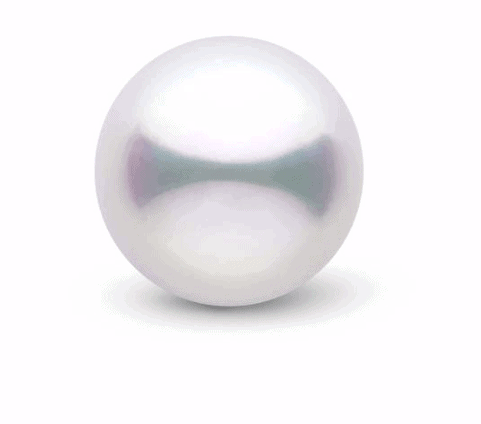
Sometimes…. perfection is boring
This is in contrast to the traditional view of what pearls should be – perfectly round, smooth and lustrous. Since pearl cultivation began commercially, in the 1900s, baroque pearls were seen as inferior but today that’s changed.
While baroque pearls might seem like a recent addition to the world of fashion, a look into history shows that imperfect pearls have often been celebrated for their uniqueness.
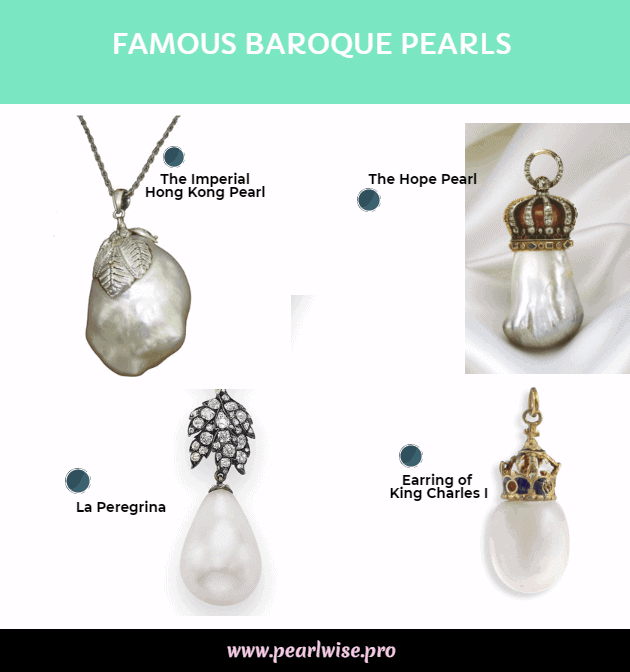
Famous baroque pearls that cost millions
Some of the most famous pearls in history have been baroque pearls. These include the Imperial Hong Kong pearl, the Hope Pearl and the pearl earring of King Charles I.
Why Choose Baroque Pearls?
Apart from their obvious physical differences with traditional pearls, choosing baroque pearls come with many advantages.
Here are 5 reasons that set baroque pearls apart from traditional pearls and make them a great option.
1- Unique Shapes
This is the most obvious difference and while in the past this was seen as a disadvantage, today it’s the shapes of baroque pearls that make them so beloved.
Because of their unique shapes, each baroque pearl is unique and has its own personality, giving them a natural, organic look. It’s very hard, if not impossible, to find two baroque pearls that are identical. As fashion trends and tastes become more non-conventional and self-expression takes the limelight, baroque pearls have become relevant.
2- Creative Jewelry Designs
Because of the shapes that baroque pearls come in, they pose a challenge to jewelry designers who often come up with creative ways to showcase the pearl’s beauty.
Traditional pearls can only be set in so many ways, but with baroque pearls, jewelers try to accentuate the individual shape of the stone. This often results in one-off, unique jewelry designs.
3- Exceptional Luster
Baroque pearls are typically very lustrous thanks in part to the bumps and ridges on the pearl’s surface that interact with light differently to a perfect pearl.
As light penetrates the layers of nacre that make up the pearl, it bounces off the crystals and back to the viewer’s eyes, creating the luster that we look for in pearls. Baroque pearls have more angles and ridges than round pearls, which allows light to refract from all directions.
This video shows the beautiful luster on a pair of baroque freshwater pearls.
4- Stunning Color
Baroque pearls have beautiful overtones that shimmer over the surface of the pearl. Regardless of the body color of the pearl, the irregular shape accentuates the color, adding stunning overtones and even orient.
Baroque Tahitian pearls are especially stunning to look at because of their unmatchable overtones with peacock, aubergine and steely green being some popular ones. Only baroque pearls have this type of color because of how the light reflects off the pearl.
5- Amazing Affordability
Regardless of all their beauty and uniqueness, baroque pearls remain affordable. All else being equal, a baroque pearl will cost significantly less than a perfectly round pearl, making it the perfect option if you want to own a strand of real pearls without paying and arm and a leg for it.
To put this into perspective, compare this baroque pearl necklace from Amazon with this round pearl necklace. Even though the baroque pearls are larger, they cost over 50% less than the strand of perfect pearls.
Types of Baroque Pearls
I mentioned above that baroque pearls is an umbrella term covering a range of sub-categories of irregular pearls.
There are about 12 main types of baroque pearls, with varying value in terms of use in jewelry and overall beauty.
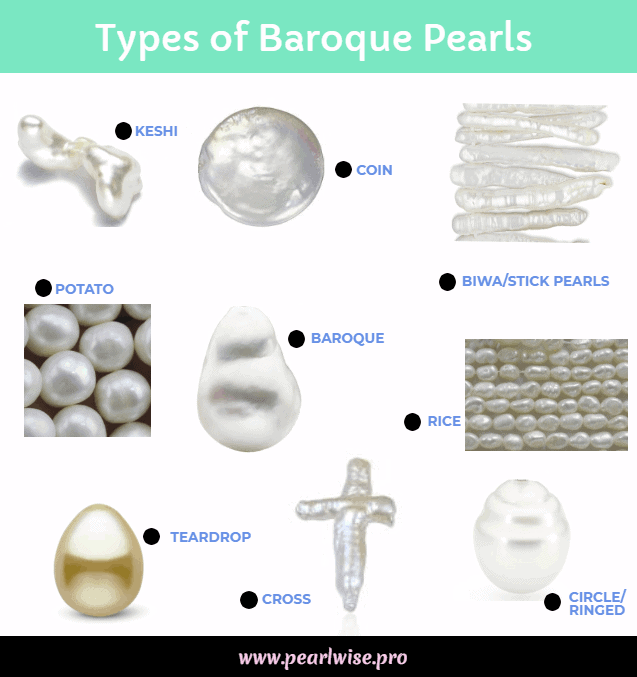
Here’s a quick rundown of the main types of baroque pearls:
- Baroque Pearls – Yes baroque is the general term but it also refers to pearls that are roundish, long and bumpy.
- Keshi Pearls – These are non-nucleated pearls that are 100% solid nacre. They come in all shapes, but what sets them apart from other baroque pearls is that they don’t contain a beaded nucleus.
- Coin Pearls – Like the name suggests, coin pearls are flat, round disks with smooth surfaces that resemble coins. These have exceptional luster and are valued in the jewelry industry as they allow for beautiful jewelry designs.
- Potato Pearls – Not the most glamorous name, potato pearls refer to large pearls shaped like potatoes. They’re roundish, bumpy pearls that have good luster and nice color.
- BIWA/Stick Pearls – These pearls are very thin and long, much like sticks. They’re ideal for statement earrings or pendants and are unlike any other pearl variety. Stick pearls have gorgeous luster due to their ridged body surface.
- Rice Pearls – These underappreciated pearls are very small and roundish, like tiny grains of rice. These are perfect for cluster jewelry designs or for layered strands. They’re not very valuable and are very affordable in jewelry.
- Teardrop Pearls – Possibly the most popular of the baroque pearl sub-categories, teardrop pearls have an elongated spherical shape that makes it perfect for drop earrings and pendants. This is among the most stylish and elegant of the baroque pearl types and is a favorite for classy jewelry. You’ll frequently see celebrities and royalty wearing teardrop pearls.
- Circle/Ringed Pearls – These bumpy and ridgy pearls are elongated with interesting circles running around their circumference. The number of rings can vary from 1-3 or more, giving the pearls a curious, almost fake look. While not exactly a baroque shape, they still come under the category of irregular pearls.
- Cross Pearls – This refers to nacre formation in the shape of a cross, which is quite rare. Cross pearls are popular for religious jewelry due to their obvious religious connotations.
Saltwater or Freshwater Baroque Pearls?
While we tend to think that perfectly round pearls are the norm, in reality, the default shape of pearls is baroque.
Over 90% of freshwater pearls are baroque, which means that this is variety is your best bet to find affordable baroque jewelry. This is because freshwater mussels aren’t bead-nucleated but are tissue nucleated. Because of this, the creature doesn’t have a ‘template’ to help it create the perfect pearl. Instead, it forms it into all shapes in an organic way.
Saltwater pearl types like Akoya, Tahitian and South Sea also yield baroque pearls but because of their beaded nucleus, they tend to produce rounder pearls in general.
Types of Baroque Pearl Jewelry
Baroque pearl jewelry come in a range of designs to suit all styles. From minimalist, understated pieces to maximalist, statement designs, there’s something for everyone with baroque pearls.
Baroque Pearl Strands
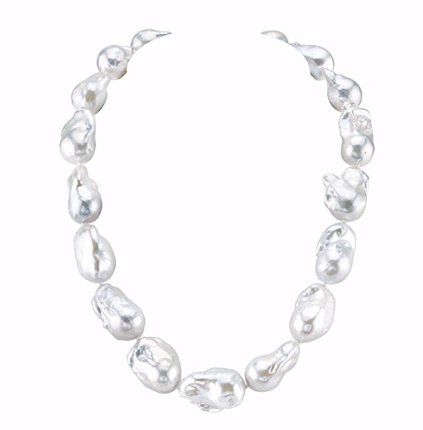
See this beautiful pearl strand here.
Baroque pearl strands, whether necklaces or bracelets, are striking and intriguing because they look so familiar and yet are very different. Larger pearls (like the one Kiera Knightley is wearing above) make for an eye-catching look, whereas smaller baroque pearls look more traditional.
Baroque Pearl Pendants
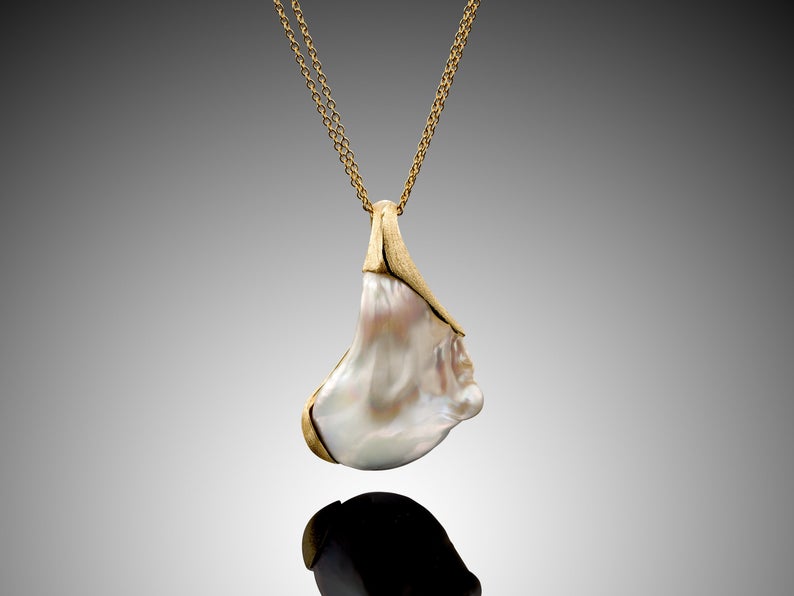
If an entire pearl strand is simply too much for you, try a baroque pearl pendant. Whether featuring just the pearl or paired with metal to create a stunning look, a pearl pendant is a staple that can be worn for any occasion.
Baroque Pearl Earrings
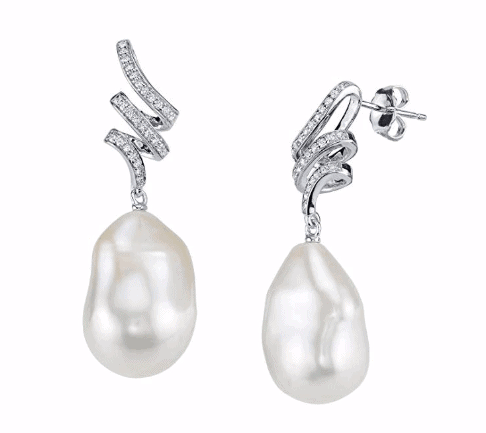
See these beautiful earrings here.
Channel your inner Dakota Johnson with a pair of baroque dangle earrings. Because of where they sit around your face, dangle earrings are immediately eye-catching, and will no doubt bring you lots of compliments.
Always find a size and shape that suits your face shape. Dangle earrings add a touch of glamor to any outfit. Teardrop dangles evoke the sophisticated style of celebrities like Kate Middleton, while biwa pearl dangles are perfect for a funky, stylish look.
- Baroque Pearl Rings
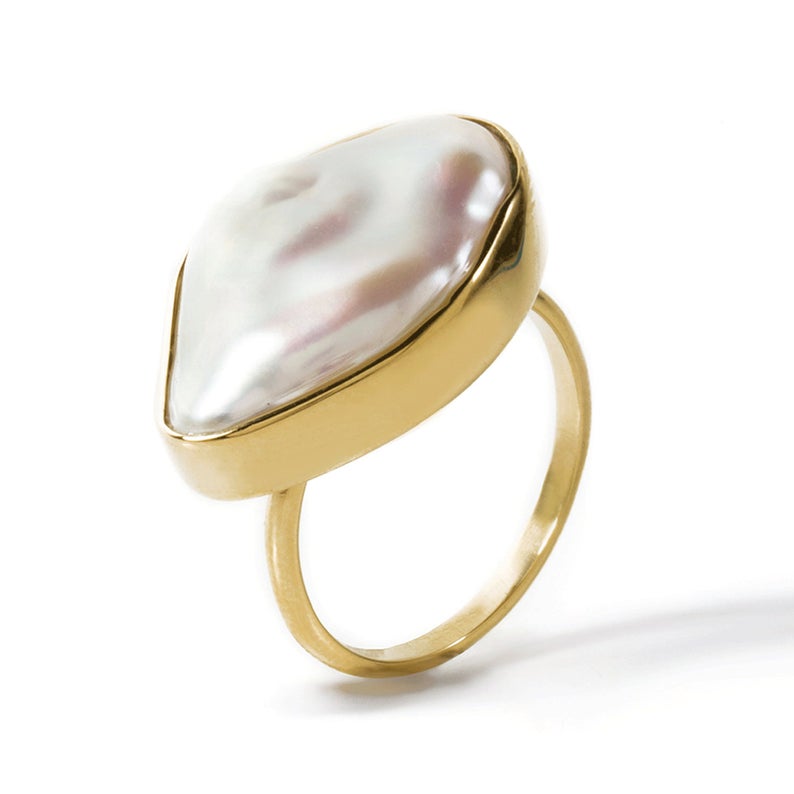
Baroque pearls in rings can be truly unique and stunning. Pearls rings aren’t ideal for daily wear because they’re not suitable for high exposure, but you can find great designs that are crafted to give the pearl more protection. A bezel or halo setting will keep the pearl safe while still showing it off to maximum beauty.
Are Baroque Pearls Worth the Money?
The value of baroque pearls rests on several factors. Not all baroque pearls are equal in value.
Most baroque pearls available are freshwater pearls, which are the most affordable of all cultured pearl varieties. So all else being equal, a baroque South Sea or Tahitian pearl will be much more valuable than a baroque freshwater.
Typical pearl value factors will be at play when evaluating the worth of your pearl. For example, the quality of luster, orient (if any), color, overtones, size and shape are some points to consider when purchasing.
The jewelry setting and materials used will also have a big bearing on the overall price of the piece. Also, big brand names will add a premium to the jewelry as well. Even so, baroque pearls are within most people’s budgets.
For example, imagine creating a strand of baroque pearls. It’s much easier because you don’t have to worry about finding identical pearls to create the perfect strand. And because baroque pearls are abundant, it becomes even easier.
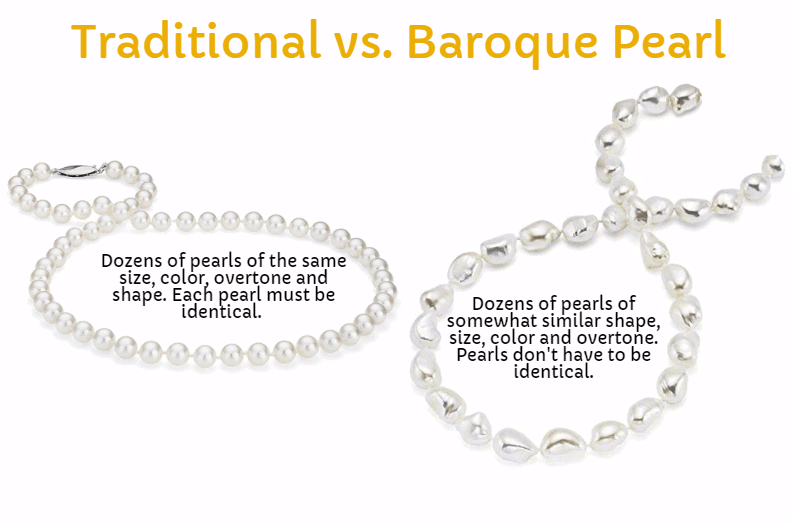
Should I Buy Baroque Pearls?
By now you probably agree with us that baroque pearls are amazing, but are they right for you? Only buy baroque pearls if you:
- Want pearls with exceptional color and luster.
- Like unique jewelry that stands out from the traditional.
- Don’t mind your jewelry being a talking point.
- Want to save money on your pearls.
- Want a range of shapes to choose from
- Want to express yourself with your jewelry
If you answered yes to these points, baroque pearls are what your heart wants!

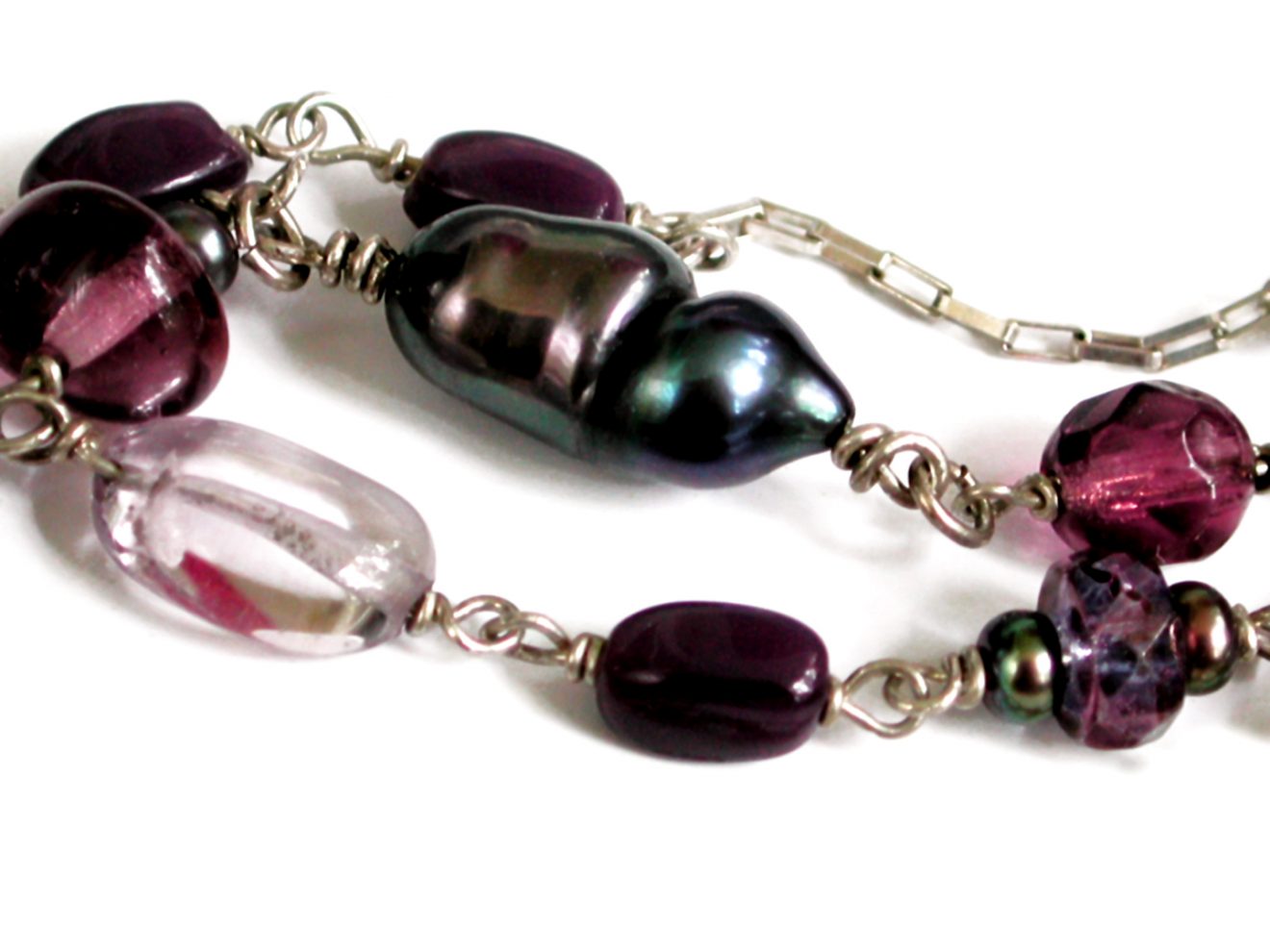

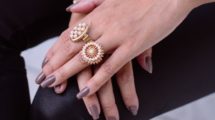


Add Comment